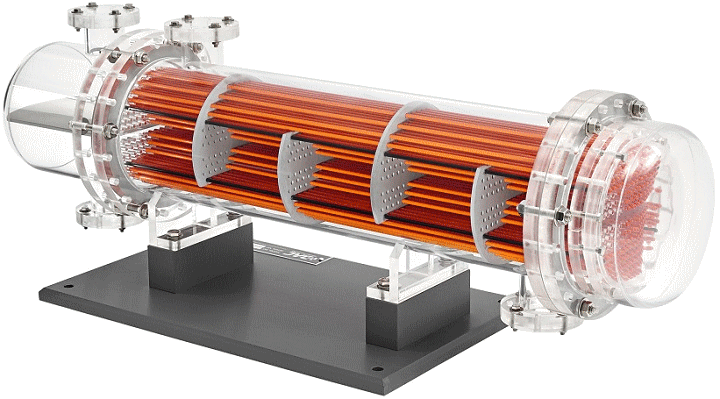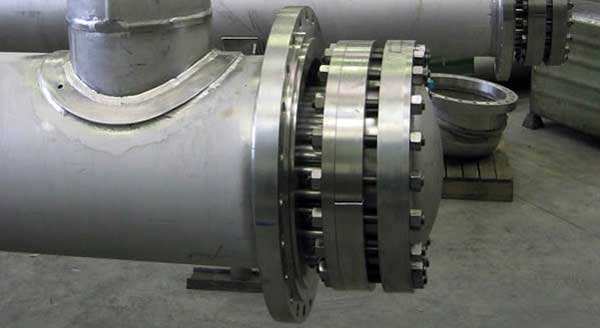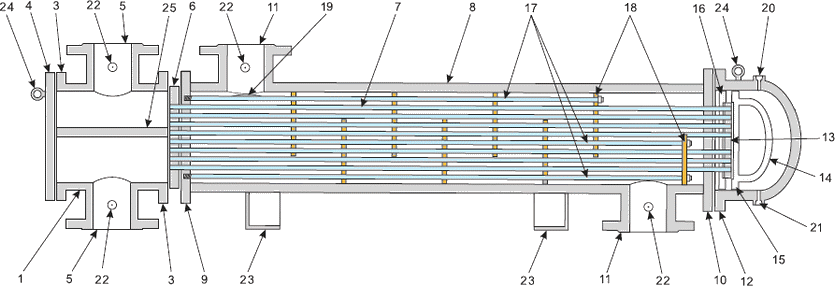 |
Floating Head Heat Exchanger |
The floating-head heat exchanger is a type of tube heat exchanger in which the tube sheet combination is independent and can move freely within the shell.
This exchanger is widely used for services where the temperature between the shell and tube bundle is high, causing expansion problems. The floating-head exchanger is the best heat exchanger in terms of efficiency and maintenance, but obviously has a higher cost.
Floating Head Heat Exchanger

This heat exchanger eliminates heat exchanger failures for industry-leading equipment life without any maintenance. Floating head heat exchangers offer unprecedented resistance to the thermal stress and fatigue found in any other type of shell-and-tube heat exchanger. Special designs of this heat exchanger are available for particle-laden air flows, corrosive applications, high temperatures and high pressures.
With high reliability and wide adaptability, the floating head heat exchanger has gained a wealth of experience during the long-term operation process and continuously promoted its development. So far, among all kinds of heat exchangers, the floating head heat exchanger is still in a leading position.
Components
As the name suggests, this design has one end of the tube plate attached to the shell, while the other is free to "float" in the shell. It also consists of a removable tube bundle consisting of straight tubes, tube plates, tie rods and baffles.
Depending on the weight and length of the bundle, there may also be slides or wheel sets to facilitate removal of the tube bundle from the heat exchanger shell. The floating tube bundle should be enclosed by a floating cover. With this equipment, the gasket joints are very large and therefore costly. In general, both the jacket and the tube bundle are free of expansion, so no thermal stress is created between the shell and the tube bundle when the temperature difference between the two media is large.

Working principle
The operating principle of this type of heat exchanger is simple. When the allowable pressure drop on the tube side is significantly low and no liquid can be introduced into the shell side, a floating head heat exchanger is recommended. The allowable tube-side pressure drop becomes the limiting factor in determining the length and number of tubes, and the shell-side pressure drop is maximized within that size by a baffle arrangement that provides the necessary performance.
Types
The floating head on a floating heat exchanger can be of different types depending on requirements. To reduce thermal stresses and provide a way to remove the tube bundle for cleaning, different floating heads have been designed. Below are four basic types..
Split Back Ring (Type S)
A Split Back Ring type unit is most commonly used in industry. In this type of construction, the floating head is mounted on the tube sheet removed from the channel. The floating head is held in place by a split support ring, allowing disassembly. The diameter of the floating tube sheet is kept slightly smaller than the diameter of the inner shell so that the entire tube bundle can be removed from the channel end.
Pull-through bundlee (Type T)
In the pull-through bundle type, one of the tube sheets is designed so small that it can be pulled through the shell. This provides access to the inside of the shell so that it can be inspected, repaired and cleaned. However, this design has fewer tubes than the others, resulting in slower heat transfer. There are fewer tubes for the cover flange and bolt circle.
Outside packaged lantern ring (Type W)
In this type, the flows on the shell side and the tube side are separately sealed by individual gaskets and separated by a lantern ring. This is the least expensive of the floating heads. This type is recommended for low pressure, low temperature and non-hazardous fluids.
Outside packed stuffing box (Type P)
In this type, a skirt attached to the float tube sheet runs through the rear end of the cap. The space between the skirt and the shell is sealed by several layers of gasket and packing gland. Unlike the external lantern ring design, it contains four tubes instead of two, transferring heat from medium to medium faster. It is recommended for non-hazardous fluids under low pressure and low temperature.
Heat Exchanger TEMA type AES with Floating Head

Part Names
Heat Exchanger - Floating Head type
Applications
- General industrial applications requiring frequent cleaning
- Chemical processing applications for toxic fluids
- Hydrocarbon fluid condensers
- Special gas aftercoolers and intercoolers
- Air pollution control systems,
- Secondary heat recovery solutions for returning heat to ovens, dryers, kilns,
- Building heating
- OEM energy recovery applications
Advantages
- No temperature limit between the two mediums
- Can operate under high temperature and high pressure, the average temperature is less than or equal to 450℃,and pressure is less than or equal to 6.4MPa.
- Easy to clean and inspection
- High reliability and wide adaptability
- Suitable for the serious scaling occasion
- Suitable for the easy corrosion occasion
- Suitable for the dirty fluid application, due to ease of cleaning
- The tube bundle can be removed for inspection.
- Possible mechanical cleaning of the outer surface of tubes
- Since tubes are straight, individual tubes can be replaced.
- Expansion of tube and shell is not a problem
- The inside tube surface can be cleaned without removing the tube bundle.
- No limitation on the number of tube side passes
Limitations
- It is costly compared to the other heat exchangers
- A large number of gasket joints
- Leakage may be a problem, unlike the U tube type heat exchanger due to the floating head.
- Installed only horizontally
- Packing materials produce limits on design pressure and temperature.
- Tubes cannot expand independently so that huge thermal shock applications should be avoided.
- To provide the floating-head cover it is necessary to bolt it to the tube sheet. The bolt circle requires the use of space where it would be possible to place a large number of tubes.
Reference(s) .. www.linquip.com
Related Post(s)

Heat Exchangers are devices built for efficient Heat Transfer from one medium to another...